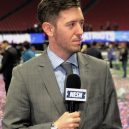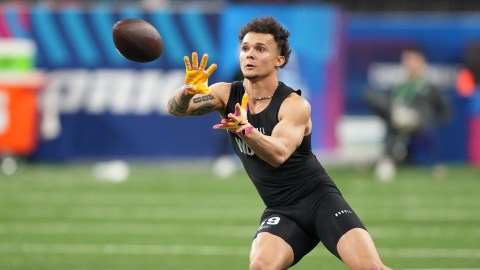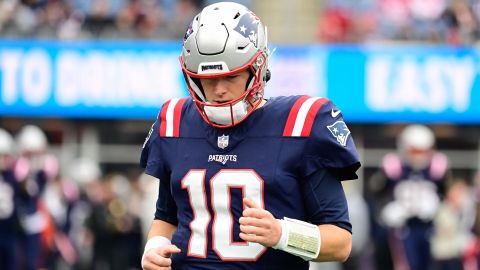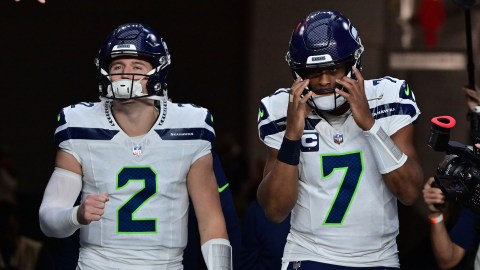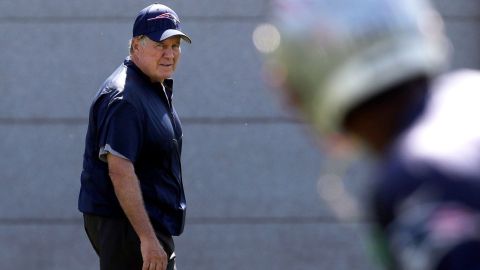 Bill Belichick is supposed to be the defensive genius, but his predecessor has started to outpace him.
Bill Belichick is supposed to be the defensive genius, but his predecessor has started to outpace him.
I’ve been watching the New England Patriots for four months, and after that, Pete Carroll’s Seattle Seahawks’ defense looks like an evolved beast. Carroll has essentially constructed two entirely different units depending on whether the Seahawks are in their base 4-3 or nickel, which helped push them into Super Bowl XLVIII against the Denver Broncos.
There’s no telling how the Patriots’ defense would have looked by midseason if Vince Wilfork and Tommy Kelly weren’t lost for the year, but New England wasn’t showing many interesting wrinkles early on. The biggest issue with the Patriots’ defense was their pass rush, which happens to be one of the Seahawks’ biggest strengths. Comparing the two teams shows how the Patriots can improve.
It was impressive that Patriots defensive ends Chandler Jones and Rob Ninkovich were able to play 97.9 and 95.5 percent of the Patriots’ total defensive snaps (highest in the NFL at the position), but there are flaws in having players stay on the field for so long — the biggest being fatigue. Jones and Ninkovich did a solid job rushing the quarterback in 2013, but they would have been more productive per snap if a third player rotated with them.
The Patriots also lacked a player who could consistently pressure the quarterback from defensive tackle. Chris Jones had some success after joining the Patriots, but that fell off as the season progressed. The fact that Jones had to play almost every snap (which is completely insane for a 300-pound rookie) didn’t help his production.
The Patriots expected to depend on Kelly or Armond Armstead in 2013, but both players got injured. Kelly and Armstead would have had to stay healthy to fully fix the Patriots’ pass rush. Most teams have two strong interior rushers on third down.
The Seahawks split snaps evenly between three pass rushers — defensive ends Michael Bennett, Chris Clemons and Cliff Avril. All three defenders can play the “LEO” role in Seattle’s base defense (a weak side defensive end who lines up split out wide and who has few responsibilities against the run). Bennett also plays defensive tackle in the Seahawks’ nickel defense.
The Seahawks have a third defensive end, Red Bryant, who weighs in at 320 pounds and can take up two gaps on the strong side in the base defense. The Seahawks play a 4-3 under, which shifts the line toward the weak side (generally, the side of the line without a tight end). That puts Bryant where a 3-4 defensive end will typically line up (four- or five-technique — over or on the outside shoulder of the tackle, while the LEO is typically at seven- or nine-technique). The LEO is able to split out so far because of Bryant’s run-stopping prowess.
Next to Bryant in the Seahawks’ base defense is nose tackle Brandon Mebane, and next to him is the “under” defensive tackle, 6-foot-7 behemoth Tony McDaniel. Defensive tackle Clinton McDonald also will rotate into the base defense, giving Mebane and McDaniel a rest.
In nickel, Bennett and McDonald line up at defensive tackle with Clemons and Avril at right and left defensive end, respectively. That puts three defensive ends on the field at the same time, including McDonald, who at 6-foot-2, 283 pounds is undersized and also a strong pass rusher.
The brilliance in putting the Seahawks’ various front-four alignments together was how easy it was to find these players. Bennett and Mebane make it tick, since they’re consistent pass rushers and run stoppers, but Clemons, Avril, Bryant and McDonald are all fairly one-dimensional players, with strengths against either the run or pass. One-dimensional players come cheaper in free agency and lower in the draft.
By mixing and matching the complete players, the run stoppers and pass rushers, the Seahawks are never completely vulnerable. It helps, of course, that the Seahawks have athletic linebackers and a top-tier secondary. But the Patriots also have solid linebackers and defensive backs.
The Patriots might not need to go so far as to use a 4-3 under base set, but getting a third pass rusher to rotate with Ninkovich and Chandler Jones is a necessity in the offseason. Acquiring a player like Bennett (or just signing Bennett — he’s a free agent), who can play outside at defensive end and inside at defensive tackle, would be perfect. Unless the Patriots have full confidence in Kelly or Armstead, they also need a bigger defensive tackle who can push the pocket on third down and in the nickel defense (the first round of this year’s draft and the free-agent crop are full of these players).
The Patriots can’t play their nose tackle, whether it’s Wilfork or Sealver Siliga, on third down. And they can’t let Jones and Ninkovich play more than 1,000 snaps.
This is an important offseason for the Patriots, and on defense, it’s all about improving depth with some key role players.
Have a question for Doug Kyed? Send it to him via Twitter at @DougKyedNESN or send it here.
